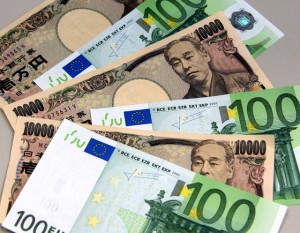 Friday’s trade saw EUR/JPY within the range of 130.89-135.10. The daily low has also been the lowest level since September 6th 2013, when a low of 129.86 was recorded. The pair closed at 132.00, losing 1.98% on a daily basis. The cross fell 3.01% for the whole week, which marked a fourth consecutive weekly loss.
Friday’s trade saw EUR/JPY within the range of 130.89-135.10. The daily low has also been the lowest level since September 6th 2013, when a low of 129.86 was recorded. The pair closed at 132.00, losing 1.98% on a daily basis. The cross fell 3.01% for the whole week, which marked a fourth consecutive weekly loss.
Fundamentals
Euro area
German Business Climate Index
Business climate in Germany probably continued to improve in January, with the respective gauge rising to 107.4 from 105.5 in December. If so, this would be the highest index reading since July 2014, when the indicator came in at 108.0.
The IFO Business Climate Index reflects entrepreneurs’ sentiment in regard to current business situation and their expectations for the next six months. The index is based on a survey, conducted by phone and encompassing 7 000 companies, that operate in sectors such as manufacturing, construction, wholesaling and retailing industry. The Business Climate Balance represents the difference between the percentage share of respondents that are optimistic and the share of respondents that are pessimistic. The balance can fluctuate between -100, which suggests all responding companies assess their situation as poor and expect business conditions to deteriorate, and +100, which suggests all responding companies assess their situation as good and expect an improvement in business conditions. In order to calculate the IFO Business Climate Index, the Balance is normalized to the average of a base year, which currently is 2005.
The IFO Business Climate Index is comprised by two equally-weighted sub-indexes – a gauge of expectations and a gauge of current assessment. The IFO expectations index probably rose to 102.5 in January from 101.1 in December. If so, this would be the highest level since July 2014, when it was reported at 103.4. The IFO current assessment index probably advanced to 110.7 in the current month from 110.0 in December and November. If so, this would be the highest index value since August 2014. In case any of the gauges registered a larger-than-projected increase, this might have a bullish effect on the common currency.
The CESifo Group is to release the official numbers at 9:00 GMT on Monday.
EUR/JPY to fall further?
The European Central Bank (ECB) outpaced the Bank of Japan (BoJ) in introducing additional stimulus on Thursday in order to revitalize economic activity.
The ECB announced a wide-scale bond-purchasing program, which includes monthly purchases of EUR 60 billion in private and public debt until September 2016. Market expectations pointed to a monthly pace of EUR 50 billion.
Meanwhile, the BoJ left unchanged its monetary policy stance at the meeting concluded on Wednesday. On October 31st the central banks Governor Haruhiko Kuroda unexpectedly announced an expansion of the bank’s annual target for bolstering the monetary base to JPY 80 trillion from JPY 60-70 trillion. According to the banks policy makers, Japanese economy continued to recover moderately as a trend, while an increase in annual consumer prices was between 0.5% and 1.0%, reflecting the drop in prices of energy products.
”The yen fell sharply on the BOJ’s action in October but euro weakness prevails after the ECB move now, so it has room to fall more against the yen,” said Kengo Suzuki, chief currency strategist at Mizuho Securities Co. in Tokyo, cited by Bloomberg.
On October 31st 2014 EUR/JPY soared to a daily high of 140.85, while on December 8th the cross touched 149.76, or the highest level since October 1st 2008.
Another event, that could mount additional selling pressure on the common currency, is the Greek vote on Sunday, as it will decide whether the country will continue sticking to the austerity policy, which guarantees a financial lifeline from creditors.
”Depending on the Greek election outcome, the euro may fall to around 130 yen, possibly into February,” Kengo Suzuki said on Friday.
Japan
Bank of Japan minutes
At 23:50 GMT on Sunday (January 25th) the Bank of Japan will release the minutes from its meeting on policy, held on January 21st. The minutes offer detailed insights on the central bank’s monetary policy stance. This release is closely examined by traders, as it may provide clues over interest rate decisions in the future. Moderate-to-high volatility is usually present after the publication. In case the minutes show a hawkish outlook, this usually supports the yen, while a dovish outlook usually has a bearish effect on the national currency.
Merchandise Trade Balance
The deficit on Japanese merchandise trade balance probably narrowed to JPY 740.3 billion during December, according to the median forecast by experts, from a deficit of JPY 891.9 billion, registered in November. In the same month a year ago the countrys trade deficit amounted to JPY 1 301 billion.
In November total exports rose at an annualized rate of 4.9% to JPY 6 189 billion, with shipments to Asia, which account for over half of Japans overall exports, increasing 5.9%. Within this category, the largest increases in exports were reported for Hong Kong (16.8%), South Korea (11.4%), the United States (6.8%) and Taiwan (3.5%). Sales to Western Europe decreased 0.5% during the same period. Total imports fell at an annualized rate of 1.7% to reach JPY 7 081 billion in November. Inward shipments of mineral fuels, which account for almost 33% of the nations total imports, declined 12.2%.
The most considerable trade deficits were reported with China, Saudi Arabia, Australia, United Arab Emirates, Russia, Malaysia and Kuwait, according to the report by the Ministry of Finance.
During the period 1970-2010 Japan has had regular annual trade surpluses. Since 2011, on the other hand, the country has been recording trade deficits, because yen depreciation led to higher costs of imports, while increased purchases of fossil fuels and gas were aimed to neutralize the loss of nuclear power after the devastating earthquake and the tsunami in March 2011.
The merchandise trade balance, as an indicator, measures the difference in value between the country’s exported and imported goods during the reported period. The balance of trade reflects the net export of goods, or one of the components to form the Gross Domestic Product. Generally, exports reflect economic growth, while imports indicate domestic demand. In case the trade balance deficit narrowed more than projected, this would provide support to the yen. The Ministry of Finance will release the official trade data at 23:50 GMT on Sunday.
Pivot Points
According to Binary Tribune’s daily analysis, the central pivot point for the pair is at 132.66. In case EUR/JPY manages to breach the first resistance level at 134.44, it will probably continue up to test 136.87. In case the second key resistance is broken, the pair will probably attempt to advance to 138.65.
If EUR/JPY manages to breach the first key support at 130.23, it will probably continue to slide and test 128.45. With this second key support broken, the movement to the downside will probably continue to 126.02.
The mid-Pivot levels for Monday are as follows: M1 – 127.24, M2 – 129.34, M3 – 131.45, M4 – 133.55, M5 – 135.66, M6 – 137.76.
In weekly terms, the central pivot point is at 133.52. The three key resistance levels are as follows: R1 – 136.16, R2 – 140.31, R3 – 142.95. The three key support levels are: S1 – 129.37, S2 – 126.73, S3 – 122.58.





